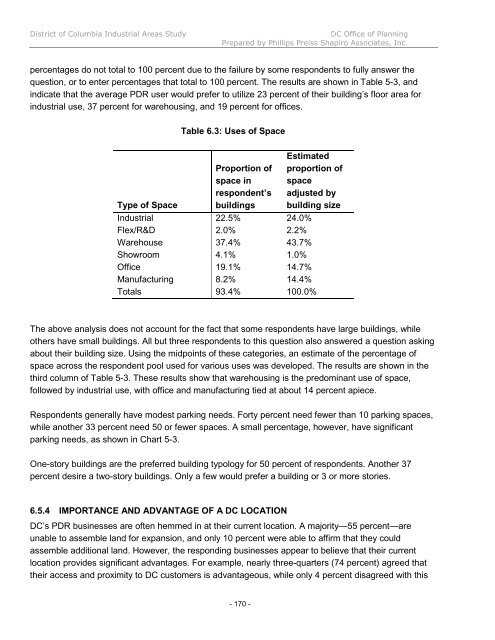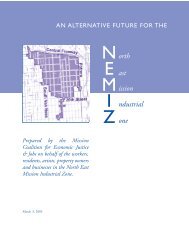INDUSTRIAL LAND IN A POST-INDUSTRIAL CITY District of ...
INDUSTRIAL LAND IN A POST-INDUSTRIAL CITY District of ...
INDUSTRIAL LAND IN A POST-INDUSTRIAL CITY District of ...
Create successful ePaper yourself
Turn your PDF publications into a flip-book with our unique Google optimized e-Paper software.
<strong>District</strong> <strong>of</strong> Columbia Industrial Areas Study DC Office <strong>of</strong> Planning<br />
Prepared by Phillips Preiss Shapiro Associates, Inc.<br />
percentages do not total to 100 percent due to the failure by some respondents to fully answer the<br />
question, or to enter percentages that total to 100 percent. The results are shown in Table 5-3, and<br />
indicate that the average PDR user would prefer to utilize 23 percent <strong>of</strong> their building’s floor area for<br />
industrial use, 37 percent for warehousing, and 19 percent for <strong>of</strong>fices.<br />
Type <strong>of</strong> Space<br />
Table 6.3: Uses <strong>of</strong> Space<br />
Proportion <strong>of</strong><br />
space in<br />
respondent’s<br />
buildings<br />
- 170 -<br />
Estimated<br />
proportion <strong>of</strong><br />
space<br />
adjusted by<br />
building size<br />
Industrial 22.5% 24.0%<br />
Flex/R&D 2.0% 2.2%<br />
Warehouse 37.4% 43.7%<br />
Showroom 4.1% 1.0%<br />
Office 19.1% 14.7%<br />
Manufacturing 8.2% 14.4%<br />
Totals 93.4% 100.0%<br />
The above analysis does not account for the fact that some respondents have large buildings, while<br />
others have small buildings. All but three respondents to this question also answered a question asking<br />
about their building size. Using the midpoints <strong>of</strong> these categories, an estimate <strong>of</strong> the percentage <strong>of</strong><br />
space across the respondent pool used for various uses was developed. The results are shown in the<br />
third column <strong>of</strong> Table 5-3. These results show that warehousing is the predominant use <strong>of</strong> space,<br />
followed by industrial use, with <strong>of</strong>fice and manufacturing tied at about 14 percent apiece.<br />
Respondents generally have modest parking needs. Forty percent need fewer than 10 parking spaces,<br />
while another 33 percent need 50 or fewer spaces. A small percentage, however, have significant<br />
parking needs, as shown in Chart 5-3.<br />
One-story buildings are the preferred building typology for 50 percent <strong>of</strong> respondents. Another 37<br />
percent desire a two-story buildings. Only a few would prefer a building or 3 or more stories.<br />
6.5.4 IMPORTANCE AND ADVANTAGE OF A DC LOCATION<br />
DC’s PDR businesses are <strong>of</strong>ten hemmed in at their current location. A majority—55 percent—are<br />
unable to assemble land for expansion, and only 10 percent were able to affirm that they could<br />
assemble additional land. However, the responding businesses appear to believe that their current<br />
location provides significant advantages. For example, nearly three-quarters (74 percent) agreed that<br />
their access and proximity to DC customers is advantageous, while only 4 percent disagreed with this












